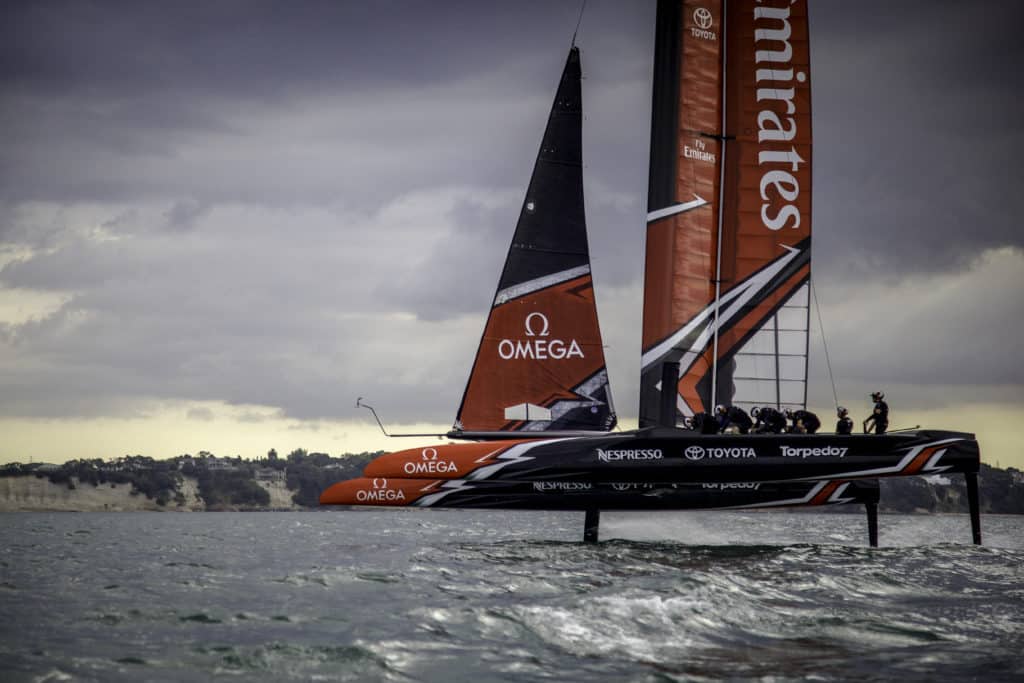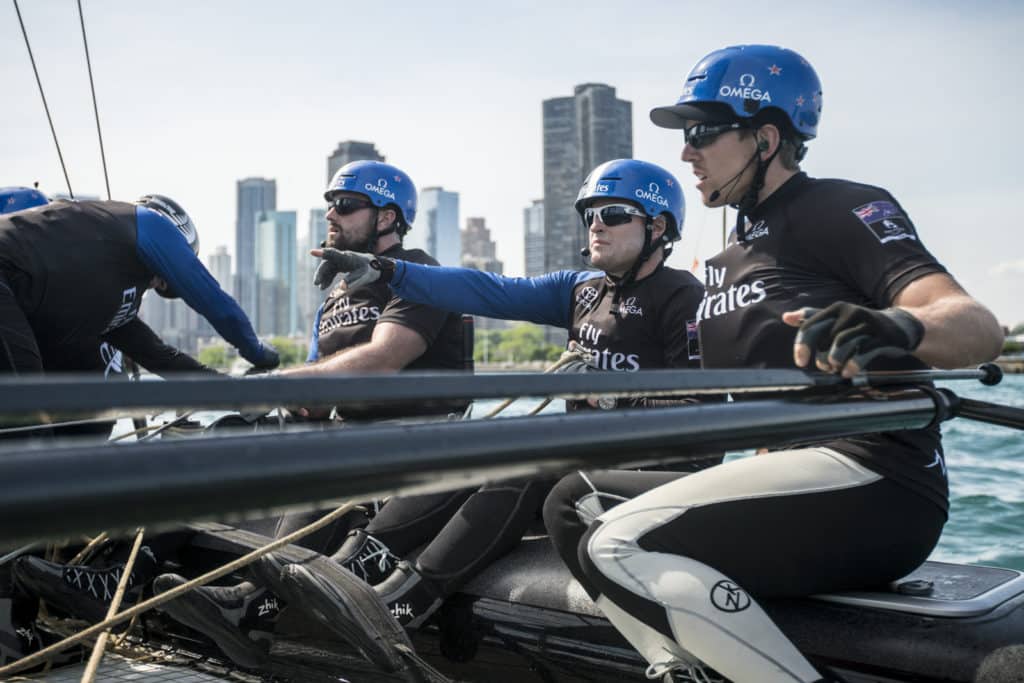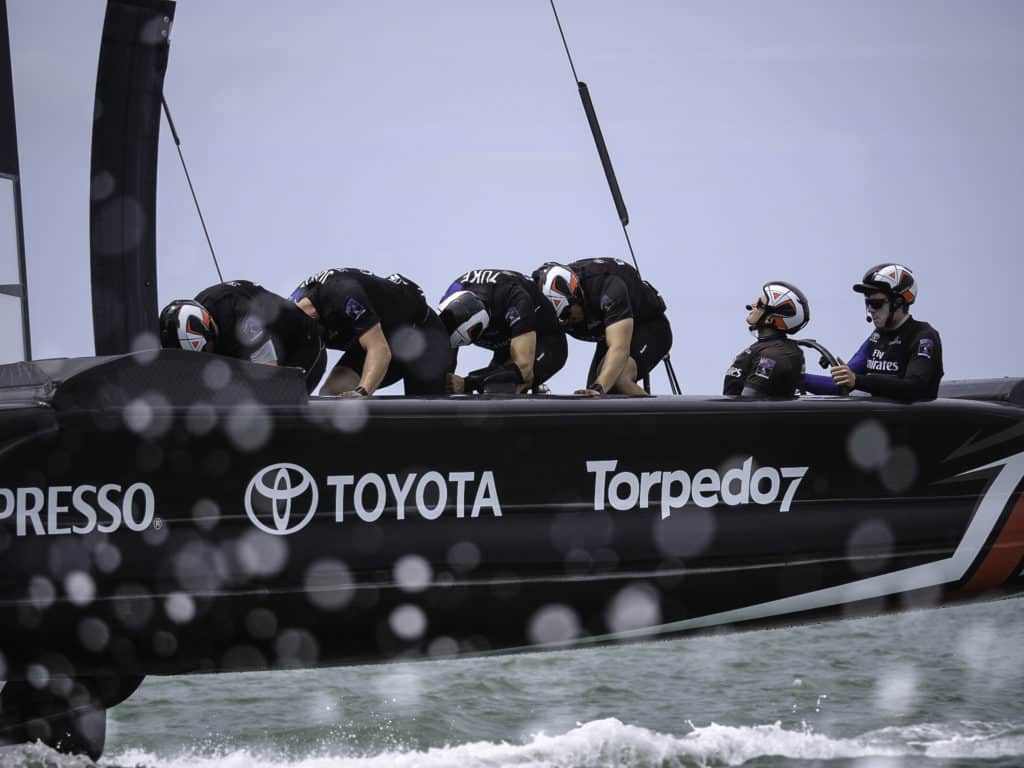
Emirates Team New Zealand sail their America’s Cup Class race boat for the third day in Auckland New Zealand
*Editor’s note: The story has been updated: Peter Burling and Blaire Tuke won Olympic silver in 2012 and gold in 2016. * For a team with the tenure of Emirates Team New Zealand, one would think the America’s Cup Event Authority, which runs the show these days, would be ecstatic to have them return for their ninth challenge under the lineage. Not so, is the Kiwi sentiment. They’re the proverbial thorn in the Cup management’s backside, and should they prevail in Bermuda this summer, they could be the most disruptive force the modern Cup has seen yet.
Team New Zealand was founded for the 1986-87 Cup off Fremantle, Western Australia, and has participated in all since, save for the 2010 Deed of Gift Match off Valencia, Spain. And the team has written some of the most epic chapters in the Cup’s storied history. There were the back-to-back victories in 1995 and 2000, which made New Zealand only the second country at the time to win the America’s Cup and defend it. Most recently, there was the near miss in San Francisco, where Team New Zealand came within one race of winning the America’s Cup for a third time, only to be felled by the historic comeback of Oracle Team USA.
In the interest of having a robust field of competitive challengers, it would seem Emirates Team New Zealand’s presence would be welcomed with open arms, but that never seems the case with the New Zealander squad, which seems to relish its regular role as the Cup’s antagonist.
“We are very much the lone wolf,” said team CEO Grant Dalton to The New York Times in a February 2017 interview. “There are five teams that want us dead now, not one, only because we’ve ruined their little parade.”
Team New Zealand’s perceived slights in the past have largely been size related. “Us against the world” is a familiar refrain for Kiwis, a storyline they love to play. Being from an island nation in the bottom of the South Pacific, they get some leeway. This sentiment helped rally the sports-mad populous during the team’s historic first Cup victory in 1995 and subsequent defense in 2000.
This time around, however, Team New Zealand’s slight comes with financial ramifications. The story goes that the America’s Cup Arbitration Panel found Team New Zealand aggrieved in a dispute with the America’s Cup Event Authority. In the first iteration of the plans for the 35th America’s Cup, ACEA had scheduled a preliminary regatta for New Zealand in February/March 2017, two months before the 35th Match for the America’s Cup in Bermuda.
Less than a year later, ACEA canceled the New Zealand regatta and rescheduled all preliminary racing for Bermuda, citing a need to “rein in costs.” Team New Zealand subsequently lost its longtime sponsorship deal with the New Zealand government, which had sponsored the team in Valencia in 2007 and San Francisco in 2013.
Team New Zealand took its case to the Arbitration Panel, a new body established for this Cup cycle, and from whose chamber no words are released, and was ultimately awarded damages that sources say rang up to the tune of more than $10 million.
Dalton believes an important part of a challenger’s role is to keep the defender on its heels, but he doesn’t even acknowledge that such an issue exists. Team New Zealand doubled down by also refusing to sign a “framework agreement” put forth by defender Oracle Team USA that binds teams entered to use the current format — namely the two-year timing, America’s Cup Class catamaran and America’s Cup World Series — for the next two editions, regardless of who wins. Artemis Racing, Land Rover BAR, SoftBank Team Japan and Team France all inked the deal.
Dalton and Cup observers, however, see the document as an act of gerrymandering that contravenes the Deed of Gift, the main governing document of the America’s Cup. “We fundamentally don’t agree with it,” says Dalton.
Dalton’s hard-edged persona is developed from hundreds of thousands of nautical miles logged in round-the-world races, but he’s also resilient. He has kept Team New Zealand on course through tough times. Funding has always been an issue for the team, which relies heavily on corporate sponsorship and also the patronage of three team board members: Stephen Tindall, among New Zealand’s top 55 wealthiest people with an estimated worth of $270 million NZD, Bob Field, the former CEO of Toyota New Zealand and, in particular, Team Principal Matteo de Nora, the Swiss-Italian millionaire who has been the main patron of Team New Zealand since its embarrassing loss in 2003.

The Louis Vuitton America’s Cup World Series Chicago
The three of them are one of the reasons Dalton is still in charge. They backed him in a coup attempt in the months following the paralyzing loss of 2013, in which Team New Zealand streaked out to an 8-1 lead before losing eight consecutive races and the America’s Cup, 9-8. That coup was led by former skipper Dean Barker and another past supporter of the Kiwi team. It also seemed to have the support of ACEA CEO Russell Coutts, the former skipper who suggested during the battle that Team New Zealand was on the brink of collapse.
When the coup attempt failed, Barker had to go. It was Barker who famously took the helm of Team New Zealand from Coutts in its series-clinching Race 5 of the 2000 America’s Cup against Italy’s Prada Challenge. He stood arm in arm with Coutts on the stage in Viaduct Harbor and hoisted the America’s Cup aloft for rabid New Zealanders to cheer.
Three months after that gleeful moment, Team New Zealand was in disarray. Coutts and four of his closest lieutenants had bolted for the big bucks of Ernesto Bertarelli’s Alinghi team from Switzerland. The fresh-faced Barker was installed as Team New Zealand’s new skipper, holding the position through 2013. But his record was less than enviable. After winning Race 5 in 2000, he went on to lose the 2003 Match 5-0, the 2007 Match 5-2, and worse, the 2013 Match despite the substantial lead.
That final loss incensed Dalton, a man who absolutely despises losing. Ever the fighter, and with the backing of the board, Dalton survived the coup attempt, and then took to reshaping the sailing team. It was time for the next wave.
Glenn Ashby, an Australian catamaran sailing whiz who was the wing trimmer in the 2013 campaign, has replaced the departed Barker, who has gone on to skipper SoftBank Team Japan. The 39-year-old Ashby is only the third skipper for the team since the 1995 campaign, and his experience in multihulls is invaluable. He helped get Oracle Team USA skipper Jimmy Spithill up to speed in the massive trimaran USA 17, which won the 2010 Deed of Gift Match. Ashby then mentored Barker throughout the 2013 cycle. He’s the right man for the right job.
Ashby’s role as skipper won’t change much from his role last time. He’ll again trim the wing and mentor a newcomer to multihull racing, the emergent Peter Burling. In the 26-year-old Burling, Team New Zealand might very well have a game changer on the order of Dennis Conner or Russell Coutts.
Burling is nearly unbeatable. He won his first world title at 15 and was New Zealand’s youngest Olympic sailor when he competed as a 17-year-old in Beijing 2008. In London in 2012, he became the second-youngest Kiwi sailor to win an Olympic medal. As a 21-year-old in 2012, he won Olympic silver in the 49er Class. As a 22-year-old in 2013, he won the Red Bull Youth America’s Cup, leading the Team New Zealand representative team.
In 2016, he and crew Blair Tuke won their first Olympic Gold in the 49er. Burling and Tuke were selected as the Rolex World Sailors of the Year in 2015. They led the New Zealand Olympic Team into the stadium for the Opening Ceremony and won New Zealand’s prestigious Hallberg Award for best sports team in 2016 based on their domination of the Olympic Regatta, which they won with two races to spare.
Burling was named helmsman in February 2015. Later that summer, he stepped into the AC45 and placed second at the first America’s Cup World Series event. He followed it up with a victory at the second regatta and another second at the third regatta.

Emirates Team New Zealand sail their America’s Cup Class race boat for the second day in Auckland New Zealand
“I think we were just having fun and learning quicker than the other guys,” says Burling. “I think we showed them how quickly we can learn and get to grips with new boats and formats. Recently we have been working hard on the Cup boat and, like everyone here, we are pretty excited about getting racing in a few months’ time.”
The turnover from an old team to a young one extends to the front of the boat as well. There’s Tuke, who’ll fill a trimmer’s role. Other new sailors include Josh Junior, who represented New Zealand in the Finn Class in Rio last summer, and Andy Maloney, a Laser sailor who narrowly missed selection for the Olympics. Team New Zealand has also recruited Simon van Velthooven, a bronze medal-winning cyclist in 2012, and Joseph Sullivan, a gold medal-winning rower in 2012. They all help lower the average age of the crew to younger than 30.
“Everyone on this team is as important as the next guy,” says Ashby. “It’s a whole team policy where we have a belief in the collective power as a whole and not any one individual to get the job done. It is very much a new team from 2013 across most departments and, as a result, we have a very healthy and fresh team culture.”
Another enduring legacy of the Team New Zealand brand is one of inventiveness. The first campaign in 1986-87 famously built its 12-Meters of fiberglass, prompting the slanderous line from Dennis Conner stating that fiberglass boats in place of aluminum is akin to cheating.
In the 1992 Cup off San Diego, Team New Zealand built the “skiff on steroids.” The undersize ACC sloop seemed unbeatable but then proved to be too small to handle the Pacific Ocean swell and waterline length of Il Moro di Venezia. Back then, waterline length mattered most.
The 1995 and 2000 campaigns featured developmental design improvements that were good enough to win the America’s Cup back to back. The 2003 campaign featured the “Hula,” the underwater appendage that was fitted on the hull between the keel and rudder, and designed to increase waterline length when sailing. It didn’t work. And the 2013 campaign developed the hydrofoils that now define the event.
Popular theory holds that if Team New Zealand hadn’t shown its ability to foil so early, it would’ve foiled all the way to New Zealand from San Francisco with the America’s Cup in tow.
That’s partly why Team New Zealand waited until the 11th hour to reveal its development trick this time around: grinding pedestals powered by legs instead of arms. The new America’s Cup class catamaran, measuring 49 feet in length, features six crewmembers whose average weight is 192 pounds, which represents a loss of five massive crew whose primary job on the AC72s of San Francisco was to grind continuously for 25 to 30 minutes to keep the hydraulics pressurized for instantaneous response.
Since the legs are naturally stronger than the arms, it reasons that one can get more power from them. The grinders — or “cyclers,” as they’ve been dubbed by some — ride on a pedestal, and that helps free their hands to work system controls mounted on handlebars.
Count Barker and Oracle Team USA’s Spithill as those who have gone on the record saying the cycle grinders won’t work. They say every team has researched it, but it comes with drawbacks: The sailors have to run across the trampoline in cleats, they have to clip in once in position, and there’s the aerodynamic factor to consider. Even Kiwi sailors admit it won’t be a game changer, but it could lead to design features that are invisible to the eye.
“If you go to leg power, maybe you get 10 to 15 percent extra power for longer periods,” said former Team New Zealand designer Mike Drummond. “So Team New Zealand, by getting more power out of their grinders for longer periods, maybe they can go to slightly faster foils.”
Only time and results will tell whether such Kiwi ingenuity is enough to propel them to the Cup Match come late June. For while they worked in isolation throughout the cold New Zealand winter, Oracle Team USA and its surrogate SoftBank Team Japan trained alongside each other in Bermuda. The two of them engaged in occasional practice races with Artemis Racing and Land Rover BAR, eventually joined by Groupama Team France, which will ultimately benefit the “Framework Five.” To emerge from the 35th America’s Cup as the lone wolf-turned-alpha male, however, would be a fitting chapter to this team’s enduring and fascinating story.









